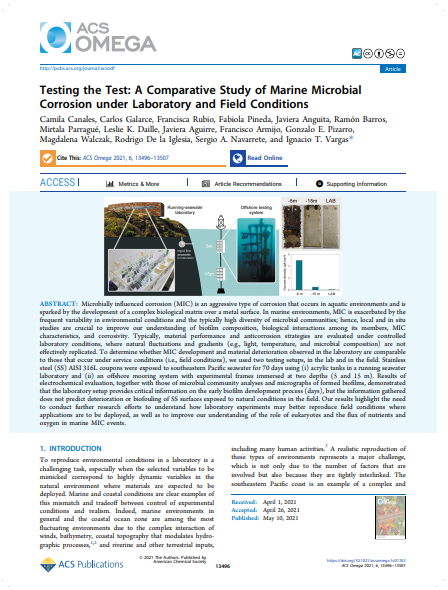Testing the Test: A Comparative Study of Marine Microbial Corrosion under Laboratory and Field Conditions

Fecha
2021-06-25Autor
Canales, Camila
Galarce, Carlos
Rubio, Francisca
Anguita, Javiera
Barros, Ramón
Parrague, Mirtala
Daille, Leslie K.
Aguirre, Javiera
Armijo, Francisco
Pizarro, Gonzalo E.
Walczak, Magdalena
De la Iglesia, Rodrigo
Navarrete, Sergio A.
Vargas, Ignacio T.
Pineda, Fabiola [Univ Mayor, Fac Ciencias, Ctr Nanotecnol Aplicada, Chile]
Ubicación geográfica
Notas
HERRAMIENTAS
Acceda a títulos restringidos
¿Cómo descargar?Resumen
Microbially influenced corrosion (MIC) is an aggressive type of corrosion that occurs in aquatic environments and is sparked by the development of a complex biological matrix over a metal surface. In marine environments, MIC is exacerbated by the frequent variability in environmental conditions and the typically high diversity of microbial communities; hence, local and in situ studies are crucial to improve our understanding of biofilm composition, biological interactions among its members, MIC characteristics, and corrosivity. Typically, material performance and anticorrosion strategies are evaluated under controlled laboratory conditions, where natural fluctuations and gradients (e.g., light, temperature, and microbial composition) are not effectively replicated. To determine whether MIC development and material deterioration observed in the laboratory are comparable to those that occur under service conditions (i.e., field conditions), we used two testing setups, in the lab and in the field. Stainless steel (SS) AISI 316L coupons were exposed to southeastern Pacific seawater for 70 days using (i) acrylic tanks in a running seawater laboratory and (ii) an offshore mooring system with experimental frames immersed at two depths (5 and 15 m). Results of electrochemical evaluation, together with those of microbial community analyses and micrographs of formed biofilms, demonstrated that the laboratory setup provides critical information on the early biofilm development process (days), but the information gathered does not predict deterioration or biofouling of SS surfaces exposed to natural conditions in the field. Our results highlight the need to conduct further research efforts to understand how laboratory experiments may better reproduce field conditions where applications are to be deployed, as well as to improve our understanding of the role of eukaryotes and the flux of nutrients and oxygen in marine MIC events.
URI
https://repositorio.umayor.cl/xmlui/handle/sibum/9088https://www.ncbi.nlm.nih.gov/pmc/articles/PMC8158798/pdf/ao1c01762.pdf
https://doi.org/10.1021%2Facsomega.1c01762
https://pubs-acs-org.bibliotecadigital.umayor.cl:2443/doi/epdf/10.1021/acsomega.1c01762
Coleccion/es a la/s que pertenece:
Si usted es autor(a) de este documento y NO desea que su publicación tenga acceso público en este repositorio, por favor complete el formulario aquí.